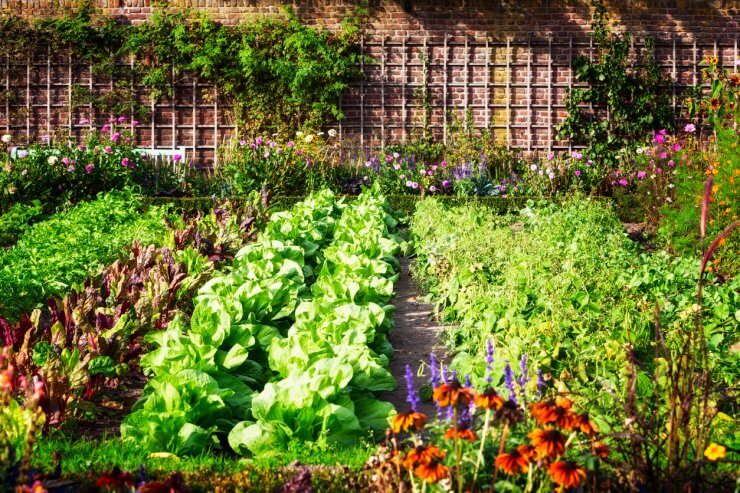
Creating a thriving organic garden in a small space may seem challenging, but smart zoning helps you make the most of every inch so vegetables, herbs and fruit trees thrive. This approach helps increase your yield in a tiny backyard, balcony or patio. It also supports a healthy, sustainable ecosystem and promotes biodiversity around your home.
Understanding Garden Zoning
Understanding zoning and fitting your plant variety into the space you have available will help your garden thrive. It allows you to strategically organize your space by grouping plants with complementary characteristics and similar growing needs for space-saving and optimal development.
Dividing your plants by their need for sunlight, watering and specific soils instead of by whether they’re vegetables, fruit or herbs will go a long way toward making your gardening endeavors more efficient. Your plants will receive healthier support and become more productive in the long run.
Using garden zoning encourages biodiversity — the variety of plants, animals, fungi and bacterial microorganisms found in a single area or region. Integrating suitable crop varieties creates a balanced ecosystem that attracts beneficial insects and pollinators while naturally reducing pests.
Zoning improves soil health because different plant types use and replenish a range of nutrients to reduce depletion risks. Grouping plants with similar needs makes watering and maintaining them easier, saving time and resources.
If you’re gardening organically, zoning your plants is particularly advantageous. It reduces chemical growing requirements to encourage sustainable practices, benefiting your garden and the environment.
Tools and Conditions for Small-Space Success
Before zoning a garden space, consider the tools needed to make your project successful. You must also consider the locational conditions of your garden site to ensure your chosen fruit trees, vegetables and herbs will thrive there.
Grow Bags
Grow bags made from breathable fabric are versatile and promote healthy root development. You can use them for seedlings or replanting growing plants, and the bags make moving them to sunnier areas of the garden easy. They can be reused and recycled, and they come in different shapes and sizes.
Grow bags are also cheaper than seedling pots and most other containers, with the added benefits of adequate drainage to prevent water damage, pests and contamination. Buying them in bulk means you’ll have a handy solution whenever needed.
Recycled Materials
Repurposing old buckets, pots and hardy shopping bags as planters is an eco-friendly and cost-effective solution. If necessary, customize these recycled containers for different plant sizes and needs. You’re reducing waste and your garden will benefit from a unique, creative and sustainable touch.
Compact Compost Solutions
Subpod composters, vermicomposters (worm bins) and bokashi systems are ideal for small-space compost generation. They transform organic scraps and garden waste into nutrient-rich compost to improve soil structure and fertility. Even a small bin tucked in a corner or under a bench can provide enough material to boost your garden’s productivity and divert unnecessary waste from landfills.
Mulch and Organic Amendments
Mulching straw, shredded leaves or compost assists with soil moisture retention, suppresses weeds and regulates the temperatures of grow bags, containers and beds. Worm castings, compost teas and other organic-based products supply essential nutrients to aid healthy plant growth. Maintaining soil health with mulch and organic products helps maximize yields in intensively planted, smaller gardens.
Locational Conditions
Understanding and assessing your small garden’s distinctive conditions before planting ensures that your vegetables and other plants flourish, meaning you can make the most of every available inch.
The sun is critical for plant health, with most vegetables and fruit trees needing six to eight hours of direct sunlight daily and most herbs requiring six hours of sunshine. Monitor your space, and note which areas receive sun and when. Consider using reflective surfaces or temporarily moving plant bags or containers to sunny spots.
Healthy soil is essential for any flourishing garden. Small spaces may lack rich ground soil, so recreate fertile conditions using raised beds, grow bags, recycled containers and composting solutions. You can check your soil’s drainage and texture by testing it in your hand — better soil will crumble more easily but should still hold together. If you have poor or pest-contaminated dirt, consider a high-quality organic potting mix and bags or containers as alternatives.
Every garden contains microclimates, which are specific areas with temperatures, moisture or wind conditions differing from elsewhere in the garden. Balconies may be warmer through reflected heat, while corners near walls might offer wind shelter.
Identifying these microclimates lets you match your plants with their ideal conditions. For example, position heat-loving peppers or tomatoes against sunny walls. Tuck your shade-happy mint or parsley in cooler spots to optimize positioning and save space.
Maximizing Small Garden Zoning Yields and Health
Get the most from your small-space garden by using shrewd, sustainable techniques to boost productivity and keep your plants healthy. Succession planting — planting a new crop as soon as you harvest one — ensures a steady supply of fresh produce.
Intercropping, or growing compatible plants, means using space effectively while naturally discouraging pests. For example, planting marigolds with basil and tomatoes will reduce flies, maggots and mosquitoes in your tomato patch.
Add organic matter to your garden to support beneficial soil microbes and replenish nutrients. Mulch suppresses weeds, retains moisture and regulates soil temperature — all imperative in containers or raised beds. Deeper watering using soaker hoses or drip irrigation, instead of frequent watering, encourages stronger roots and minimizes water waste.
Plant flowers among your vegetables and fruit during garden zoning to control pests organically. Adding dianthus or nasturtium will encourage butterflies, bees and other pollinators. Protect your more vulnerable plants with row covers or other physical barriers. Use natural remedies like insecticidal soap or neem oil to address pest appearance early.
Eliminate Small Space Zoning Errors
Common mistakes can restrict your garden’s yield. Overcrowding when planting can lead to stunted growth, and the excessive humidity generated can cause increased disease chances. Research your pairings to ensure compatible plants that reduce resource competition and deter pests. Last, don’t neglect your soil’s health — refresh it before reuse to maintain and grow its nutrients.
Your Crops Can Fit Into One Small Space
Fully understanding and properly implementing garden zoning can make your small garden space a success. Pay attention to the finer details to improve your yield, and ensure you assist in sustainability initiatives through your planting processes. Improving your garden’s natural environment will ultimately mean better results.



